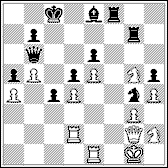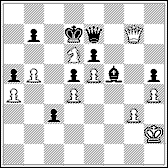 |
Sergey Ivanov,
|
Alekseev, Evgeny (2300) - Ivanov, Sergey (2548)
St.Petersburg Men Championship, 1999
[C02]
|
1. e4 e6 2. d4 d5 3. e5 c5 4. c3 Nc6 5. Nf3 Bd7
I think, this is a more flexible continuation compared to the classical 5...Qb6 , for Black keeps a possibility to develop his queen on the square c7 , intending to play against the pawn e5 by f7-f6 .
In the case of 6. Bd3 Black can switch the game to the old Milner-Barry gambit by 6...cxd4 7. cxd4 Qb6 . Modern theory consider this opening as safe for Black. Interesting is also 6...Rc8!? 7. a3 ( 7. O-O cxd4 8. cxd4 Nb4 ) 7...cxd4 8. cxd4 Qb6 9. Bc2 ( 9. O-O Nxd4 10. Nxd4 Qxd4 11. Nc3 Qxe5 12. Re1 Qb8! ),
and now sudden 9...g5!? 10. h3 Nxd4! 11. Nxd4 Bc5 12. Ne2 Bxf2+ 13. Kf1 f6 leads to a sharp and unclear position, E.Sveshnikov - A.Chernin, Riga, 1985. Often used is 6. Be2 , and Black can choose between two main plans: to attack the pawn d4 - 6...Nge7 7. Na3 cxd4 8. cxd4 Nf5 9. Nc2 , or to remove the pawn e5 - 6...f6 7. O-O fxe5 8. Nxe5 Nxe5 9. dxe5 Qc7 10. c4 O-O-O 11. cxd5 Qxe5 . 6...f6 7. Bd3
7. exf6 gxf6 8. Nh4
is countered by
8...Qe7 9. Qh5+ Qf7
12...Qe8!? 13. Bxf6 gxf6 14. Bxh7+ Kg7 15. Bg6 Qe7 16. Nxd7 Qxd7 17. dxc5
Bxc5 18. Bd3 e5
Other possibilities - 7...fxe5 8. Nxe5 Nxe5 9. dxe5 Ne7 10. O-O Qc7 with a double-edged play, or 7...cxd4 8. cxd4 Nh6 9. O-O Nf7 10. Re1 Be7 11. Nc3 O-O
12. Qc2 f5 13. Nxd5!? exd5 14. e6
Risky is 8...fxe5 9. Nxe5 Nxe5
10. Bf4!
(quite good is also is
10. dxe5 Qxe5?! 11. Re1 Qd6
12. Qh5+
9. Bf4 looks temptingly, but it turns out to be unsuccessful at this situation, for the bishop just stimulates activation of black pawns: 9...c4 10. Bc2 h6!
11. h4
(
11. Bg3 f5 12. h4 Be8
)
11...Be8 12. b3 cxb3 13. Bxb3
Bh5 14. Nbd2 fxe5
(
14...g5!
)
15. dxe5 Bc5 16. Qb1 Nge7
Here 10. Nxe5 Nxe5 11. Bf4?! is obviously insufficient - after 11...c4 12. Bc2 Qb6 13. Bxe5 Qxb2 14. Nd2 Qxc3 White has no compensation for two pawns.
White planned a strike c3-c4 , so Black radically prevents it, bearing in mind that it is difficult for a white knight to occupy the ideal square d4 , because the pawn e5 is weak. 11. Bc2 Bc5 12. Nbd2It would have been profitable for White to exchange black-square bishops - 12. Be3 Bxe3 13. Rxe3 ,
but in this case Black would have got counterplay: 13...Nh6 14. h3 Nf7 15. Qe2 g5 16. Nbd2 Rdg8 17. b3 h5 . 12...Nh6Looking closely not only to the pawn e5 , but also to the square f2 . 13. b4 Bb6 14. h3 Nf7 15. Qe2White has strengthened his outpost on the square e5 and intends to drive the enemy knight from c6 , in order to activate his "runner" on the square d4 . Black needs to undertake counter-actions quickly.
Setting up an ambush - to attack the square f2 ! 16. Kh1White makes a prophylactic move, hesitating to 16. a4!? (it's more precise than immediate 16. b5 Ncxe5! ) 16...a5 17. b5 Ncxe5! 18. Nxe5 Nxe5 19. Qxe5 Bxf2+ 20. Kh1 Bxe1 21. Qxe1
21...e5 22. Ba3 ( 22. b6!? ) 22...Rf6 23. Nf3 Bf5 . The position is hard to estimate, but White is at least not worse because of the unsafe position of the black king. 16...g5After the white king has moved to the square h1 , a pawn attack becomes more effective. 17. a4 a5 18. b5 Ne7
More active was
19. Ba3
Preventing files opening: if g5-g4 , then h3-h4 . 20...Rfg8 21. Ng3 g4 22. h4 Ng6
An important achievement of Black: now White is forced to exchange his light-square bishop. 23. Bxg6 Rxg6 24. Nf1Threatening was 24...Qd8 , and the pawn h4 is defenceless. 24...Qd8 25. g3 Rf8The position seems to be even. Pawn chains enclose all the board, making breakthroughs into an alien camp difficult. Nevertheless, Black has some possibilities to reinforce his pieces; for example, he can transmit his light-square bishop along the route d7-e8-g6 and double his rooks on the file f . Also the pawn e5 is weak, and White has to play extremely careful. 26. Ba3 Re8
White doesn't feel danger. Neccessary was 27. Bc1 , and if 27...Bc7 , then 28. Bf4 . 27...Bc7! 28. f4White has to permit the opening of the file g , for not to lose the pawn e5 . 28...gxf3 29. Nxf3 Reg8Black pieces have revived and have found new objects to attack. 30. Qf2 Nh6 31. Bc5 Ng4It seems that 31...Nf5 32. Ng5 Rxg5 33. hxg5 Qxg5 with a number of threats was even stronger.
Erroneous was 32. Qe2? Nxe5! 33. Nxe5 Rxg3+ A) 34. Kh1 Qxh4+ ( 34...Rh3+ 35. Nh2 d4!? ) 35. Nh2 Rh3 with a heavy attack
B)
34. Nxg3 Rxg3+ 35. Kf1 Qxh4
Threatening to double rooks on the file f and to breakthrough into the White's camp. 35. Ng5 Bxd4+ 36. cxd4 Qb6 37. Rd2 Be8A "French" bishop, sleeping so far, intends to enter play with a decisive effect. 38. Nh2
Having reach a strategically winning position, Black makes a serious error. Simple 38...Bg6 39. Nxg4 hxg4 40. Qe2 Bf5 would have left no chances for White: the knight g5 is hobbled, Black can prepare the queen's transmit to the square b4 without haste and, binding White pieces, rush to the file f . Black had also a tactical possibility: 38...c3!? 39. Rd3 Rf2 40. Rxc3+ Kb8 , forcing White to give the queen away. 39. Kxh2 Bg6 40. Rf1 Rxf1 41. Qxf1The time control had passed, there was the time to deepen in a position. As it seemed to me, I found the way to win. 41...c3
41...Bf5
would have now been met by
42. Qf3
. However, after
42...Kb8!
(
43. Qxh5 c3
A brilliant defence! White rook puts its' body in the way of a black passed
pawn. Other attempts were unsufficient:
42. Qf8+ Qd8 43. Qxg7
(
43. Rf2 Qxf8 44. Rxf8+ Kd7 45. Rb8 c2 46. Rxb7+ Kc8 47. Rxg7 c1=Q
Curiously, here Black could lose: 43...Qd8? 44. Qxg7 Bf5 45. Nf7 Qe7 ( 45...c2? 46. Nd6+! Qxd6 47. exd6 c1=Q 48. Qf8+ Kd7 49. Qe7+ Kc8 50. Qe8# ) 46. Nd6+ Kd7
47. Qh8 Qd8 48. Qxh5 c2 49. Qh6 . 44. Qxg7+ Kb8 45. Qf8+!
Just so - a queen must keep the file
f
and the diagonal
a3-f8
under control. Erroneous was
45. Qg8+? Ka7 46. Nxe6 Bxa4 47. Nc5 Qxb5
After perfectly carrying out a difficult defence, my young opponent took a false last step. Leading to draw was 46. Nf7! Qxd4 47. Nd6 Qd2+ 48. Kg1 Qe1+ 49. Kh2 , and Black has no more then a perpetual check. 46...Qxe6 47. Qc5+ Qb6 48. Qxc3 Bxa4 0:1 |
|
|
Next game, annotated by S.Ivanov |
|
|
Previous game, annotated by S.Ivanov |
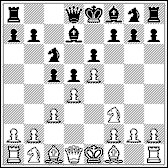

 Interesting is
7. b4!?
fxe5
(
7...c4 8. Be2 Qc7
)
8. b5 Na5 9. Nxe5 Nf6 10. Bd3
(
10. Bg5!? Be7 11. Bd3 O-O 12. Nd2
Interesting is
7. b4!?
fxe5
(
7...c4 8. Be2 Qc7
)
8. b5 Na5 9. Nxe5 Nf6 10. Bd3
(
10. Bg5!? Be7 11. Bd3 O-O 12. Nd2
 , M.Kiselev - S.Ivanov, Yerevan, 1983)
10...Bd6
(
10...c4!?
)
11. Bg5 O-O 12. Qc2
, M.Kiselev - S.Ivanov, Yerevan, 1983)
10...Bd6
(
10...c4!?
)
11. Bg5 O-O 12. Qc2


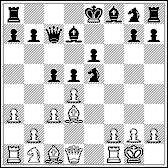
 )
10...Qb6
(
10...Bd6 11. dxe5
)
10...Qb6
(
10...Bd6 11. dxe5
 )
11. Bxe5 Qxb2 12. Qh5+ Ke7 13. Qg5+ Nf6
14. Nd2
)
11. Bxe5 Qxb2 12. Qh5+ Ke7 13. Qg5+ Nf6
14. Nd2

 , M.Adams -
V.Epishin, Ter Apel, 1992.
, M.Adams -
V.Epishin, Ter Apel, 1992.

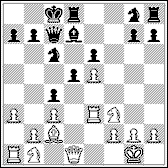



 19...Bc5
(
19...Re8
is more reliable)
20. b6!? Qxb6
(
20...Qc6 21. Nd4 Bxd4 22. cxd4
19...Bc5
(
19...Re8
is more reliable)
20. b6!? Qxb6
(
20...Qc6 21. Nd4 Bxd4 22. cxd4
 )
22. Bxc5 Qxc5 23. Nd6+ Nxd6 24. exd6 Qxd6 25. Nxg5
)
22. Bxc5 Qxc5 23. Nd6+ Nxd6 24. exd6 Qxd6 25. Nxg5
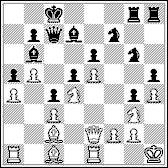
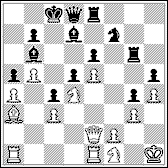
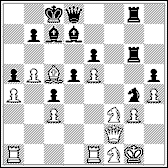
 Deserving attention was
32. Qd4
,
and White doesn't allow Black to occupy the important diagonal
g1-a7
.
Deserving attention was
32. Qd4
,
and White doesn't allow Black to occupy the important diagonal
g1-a7
.
